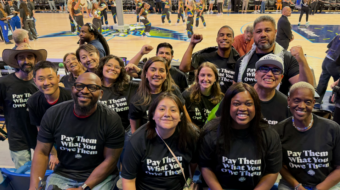ROME, Feb 13 (IPS) – Shipping used to be for men. Now women are starting to be seen commanding merchant vessels, oil tankers and cruisers, ‘manning’ ships and operating liner engines.
In an e-mail interview with IPS, Sarah Finke – the Women’s Officer at the International Transport Workers’ Federation (ITF) – discusses some of the challenges faced by women on ships, and the role of unions in this tough sector. The ITF includes 654 unions representing about 4.5 million transport workers in 148 countries.
IPS: The ITF says ‘millions of women work in the transport industry world-wide’. How many of these are in the maritime sector?
Sarah Finke: We estimate that there are around 23,000 women seafarers worldwide, representing a low 2 percent of the total workforce, and clustered disproportionately in the ferry and cruise sectors, and in service roles. The total number is slowly increasing, as is women’s representation in the ranks of ships’ officers and masters. But it is an unacceptably slow process, and one that trade unions have to lead and drag forward.
IPS: Which countries ‘produce’ more women seafarers?
SF: It largely shadows the situation for men, with the Philippines and Indonesia (the biggest seafaring nations in the world) ranking highest, but also with significant numbers of Eastern Europeans, which reflects that region’s history of cruising and cruise fleets.
IPS: In 2005, at a conference in Rio de Janeiro, a group of 40 female seafarers called for greater attention to job prospects for women and discrimination. ‘Sexual harassment is a reality for many women at sea,’ says a recent International Labour Organisation (ILO) report. Has anything changed?
SF: It will take a new research project to establish an improvement on the ground, but there are hopeful signs. Positive measures on bullying and harassment have been introduced by European ship owners and by unions in the European Transport Workers’ Federation, the ITF’s European arm. There has also been real campaigning by our affiliated unions for equality and against violence towards women.
IPS: They also noted that ‘the flag of convenience system is a barrier to the promotion of gender equality, and that the effects of outsourcing to ever cheaper labour markets has made the situation worse.’ Why is this connected to equality?
SF: Because terms and conditions may be inferior, denying job and promotion opportunities. They are governed by the legislation of the flag state, which may not give any rights at all. Family-friendly policies and measures covering pregnancy and maternity vary widely, along with the right to return to work after having a child.
However, minimum rights in equality and pregnancy are included in ITF approved agreements, which we seek to put in place on FOC (flag of convenience) vessels in order to ensure basic protections for those working on them.
IPS: Could you give an example of the sort of obstacles women encounter?
SF: Two examples with names omitted for obvious reasons: A woman cook on an FOC ship was told verbally by the master that it was time for her holidays and she could sign off the ship for six weeks. She had no written contract. Another colleague secretly told her the managing agent had stated that it was not company policy to employ women on board. The ITF intervened on her behalf and got her reinstated in her job.
A stewardess on another FOC cruise ship, who was four months pregnant, was signed off. She was happy about this but unhappy that the company did not want to pay her repatriation expenses. The ITF got the company to pay.
IPS: According to the International Maritime Organisation (IMO), the estimated number of women at sea in the world remains low, but seafarers’ unions’ female membership is higher in comparison, at around 6 percent…
SF: Probably because there are specific issues regarding woman and work – for example sexual harassment, inequality and maternity right – which unions can help with. The figures also reflect a high number of women in the cruise and ferry sector in Northern Europe, where union membership is traditionally higher than in many other areas. For example around 30 percent of the seafaring membership of the Seko Swedish general workers’ union (the Swedish Union for Service and Communications Employees) are women: 2,754 out of 7,367.
IPS: According to female seafarers, unions need to give women more voice. What presence do they have at the ITF?
SF: The ITF Executive Board has 40 members, of who seven are women. A 30-strong women’s committee advises the Board and provides elected regional and sectional representatives who feed in to all the ITF’s work. An example would be Jaqueline Smith, president of the Norwegian Seafarers’ Union. Nine out of the ITF’s 130 inspectors – who undertake some of the ITF’s most dangerous and difficult work – are women.
IPS: Seafaring is a dangerous profession: accidents happen, ships are hijacked … Do these incidents pose special problems for women?
SF: We’re not aware of many women having been among the pirated vessels, except, possibly on the Faina (hijacked in Gulf of Aden by Somali pirates last year with 20 Ukrainian, Latvian and Russian sailors on board). There were no reports of special problems. Going back beyond the current wave of attacks, there was the case of Deborah Harrison, a British Numast (the National Union of Marine, Aviation and Shipping Transport Officers, now Nautilus), who was used as a human shield by hijackers in Brazil (in 1998), and was shot and seriously wounded as a result.
*Miren Gutierrez is IPS Editor in Chief









